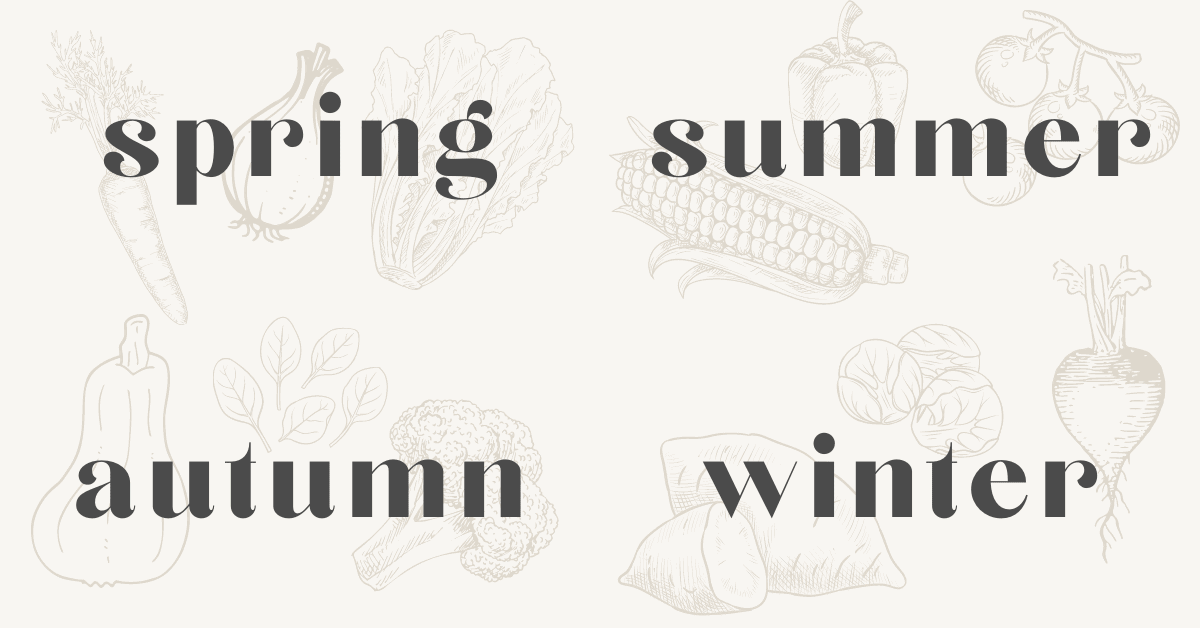A guide to the seasonal vegetables that are available throughout the year! Learn which vegetables are readily available and taste best during specific times of the year.
Eating Seasonal
Seasonal eating has been a pillar of So Happy You Liked It since its inception. I’ve always maintained that the freshest ingredients don’t need much to taste amazing, which is why seeking out seasonal produce is a good rule to abide by.
There’s more to eating seasonal, though. It’s good for the environment since food that’s in season doesn’t need to travel as far of a distance as those that aren’t. This also means that it will be more affordable than items that are out of season (again, think about those transportation costs!). And of course, it’s good for your tastebuds. Food that’s picked at its peak tastes fresher, brighter, and more delicious.

What Does In Season Mean?
First and foremost, you may be scratching your head wondering, “What does ‘in season’ even mean? It’s not like bananas are being grown in Minnesota right now…”
When an item is harvested or at its peak flavor, it’s considered to be in season. Many geographic growing regions are able to grow specific items year-round, or at least for a better part of the year. This is why you may see certain vegetables listed in multiple seasons in the lists below.
Use the following lists of seasonal vegetables to inform your purchasing so you’re seeking out the freshest vegetables during their season.
Spring Vegetables
After a winter filled with hearty ingredients and stick-to-your-ribs-style meals, the freshness that Spring brings is welcome. The vegetables that are considered to be in season during the gradually warmer months are excellent prepared in a variety of ways, but enjoying them raw or minimally cooked allows their fresh flavor to shine. Raw radishes and blanched asparagus are the perfect addition to a delicious grain salad. Carrots are perfectly roasted and topped with shredded coconut and crunchy pistachios. Long-awaited Spring garlic enhances vinaigrettes, soups, and stir-frys.
The produce of Spring inspires us to eat light and seek out the items that are available during this short yet delicious season.

Summer Vegetables
Summer ushers in an abundance of delicious produce. Farmer’s Markets are brimming with all sorts of locally grown produce, making them the best option to seek out the freshest items in your area. Tender zucchini gets the Caeser treatment with crunchy breadcrumbs and sharp Parmigiano. Freshly shucked corn graces creamy swirls of linguine and tender morel mushrooms. And nothing beats a tomato sandwich (I wait all year to gorge myself!).
Summer is a time to eat fresh and preserve as much of the incredible produce this season has to offer.

Autumn Vegetables
As the temperatures begin to dip, our appetites naturally gravitate to heartier and more substantial meals. Brussels sprouts are roasted to perfection in this simple recipe. Pumpkin can be used in countless ways, as made evident in this article which highlights 25 Pumpkin and Squash Recipes. This lasagna packs some of Fall’s most delicious vegetables into one savory dish.
The produce that Autumn brings allows us to ease into the cooler months by way of comfort cooking.

Winter Vegetables
The produce that’s in season during the winter are those that primarily have very long shelf-lives. They can be stored for potentially months, if stored properly. Winter squash stars in this flavor-packed chili. Sweet potatoes are transformed into a hearty meal with delicious topping options. Kale steps into the spotlight in a creamy familiar dip.
Winter is a wonderful time to get creative with the vegetables that are in season and to try new cooking methods.

Find this collection of seasonal vegetables helpful? Check out my “So Happy In The Kitchen” page, where I share helpful roundups of products, ingredient and cooking method education, and recipe tips and tricks! You can also shop all of my favorites here.
Let’s be friends! Find me on Instagram, Facebook, and Pinterest.

